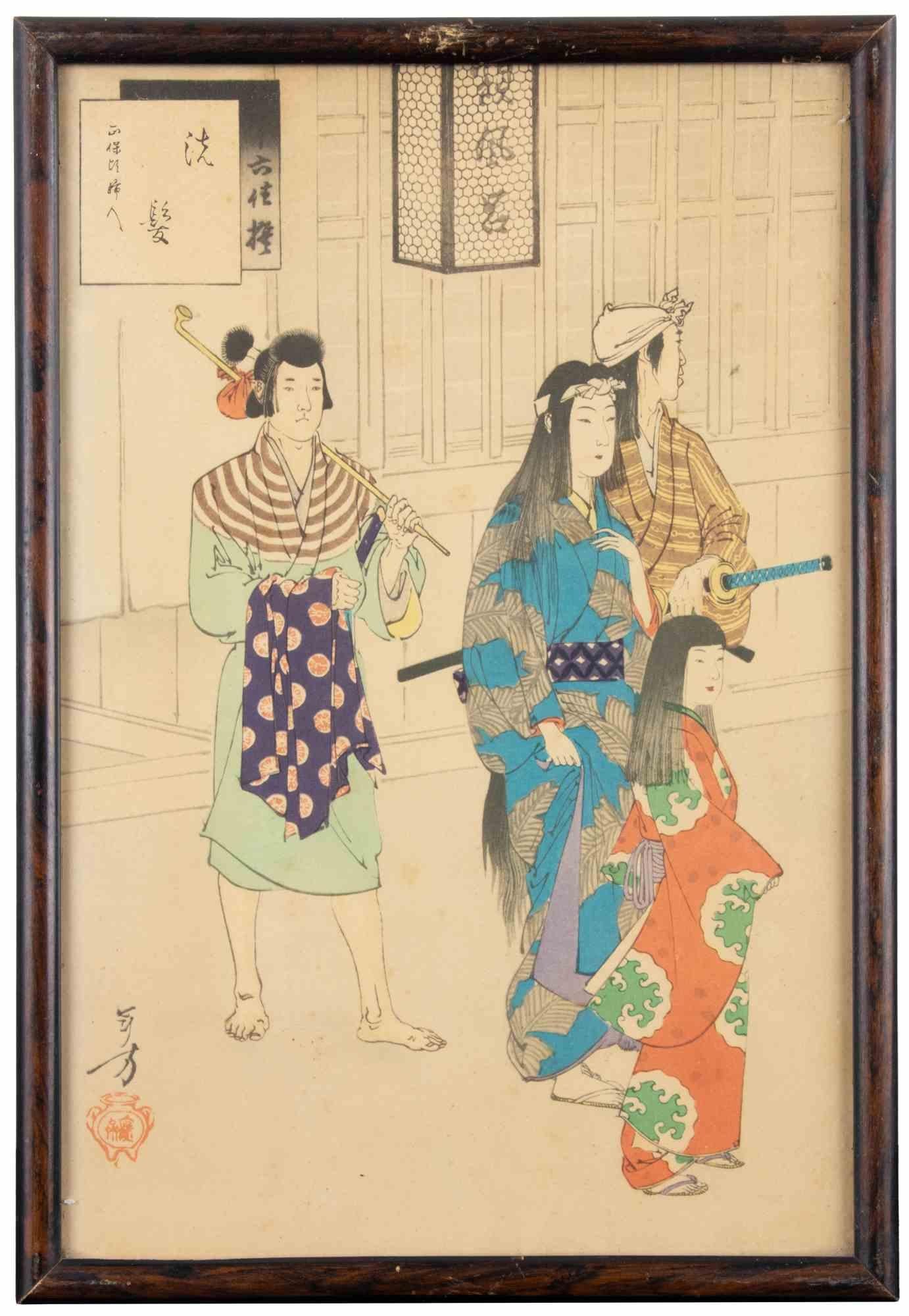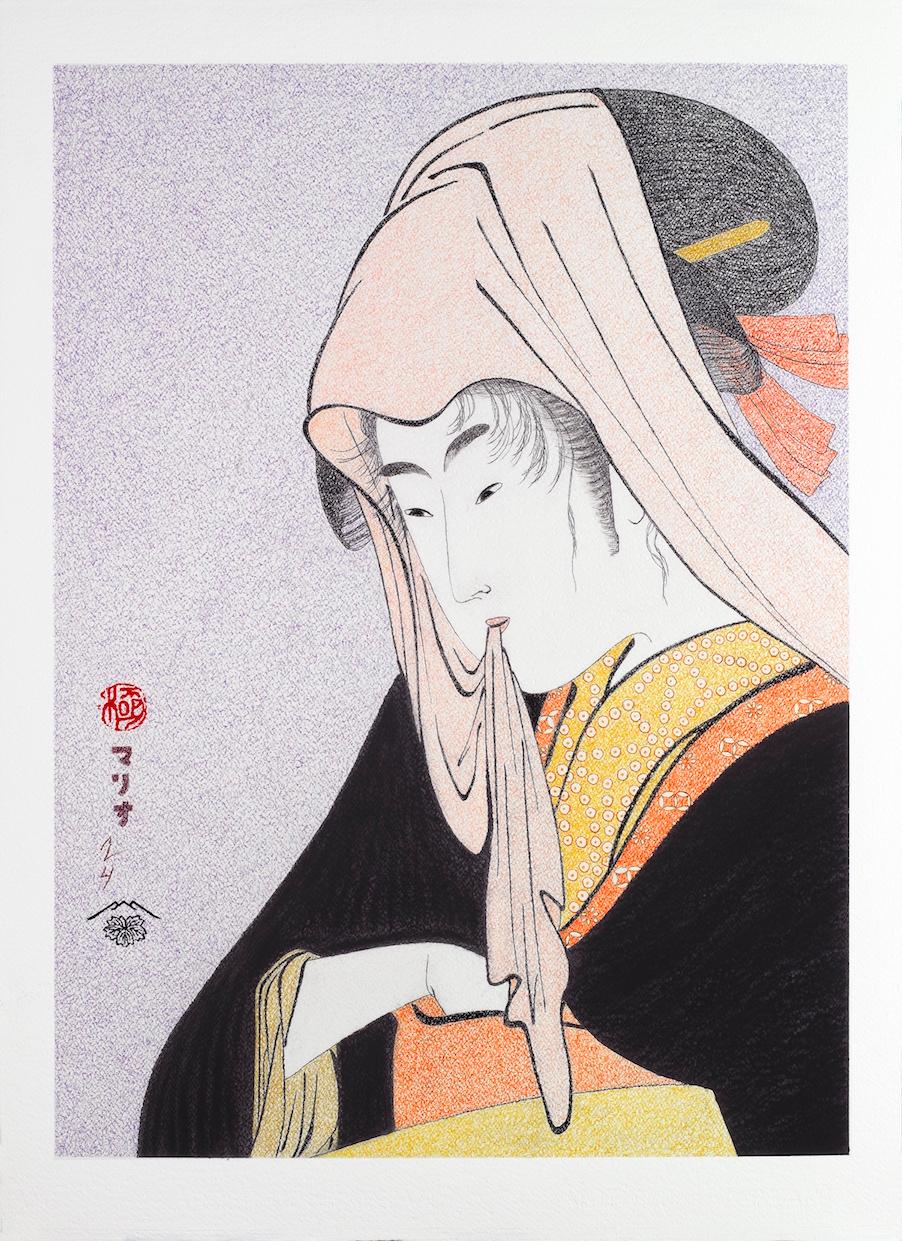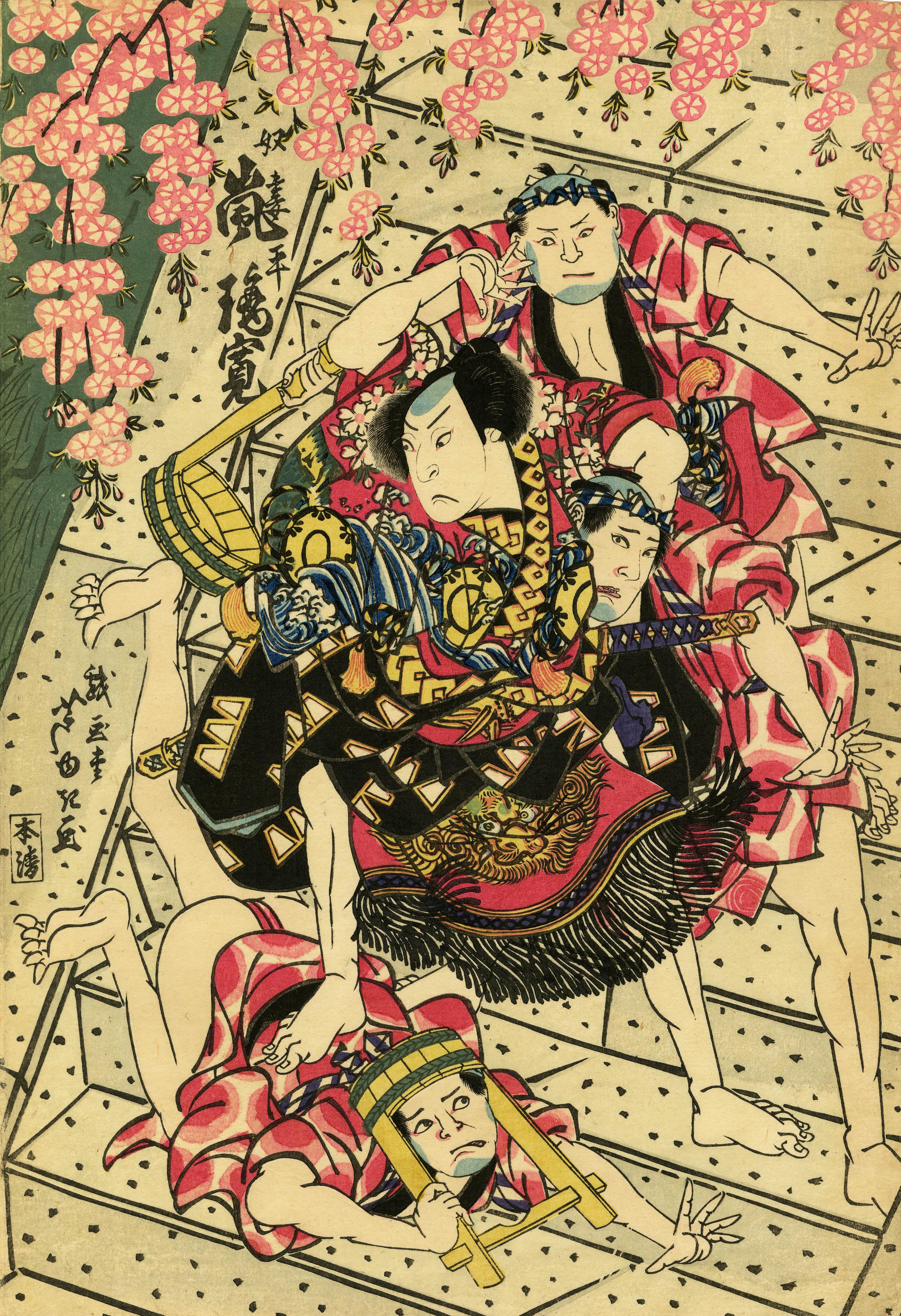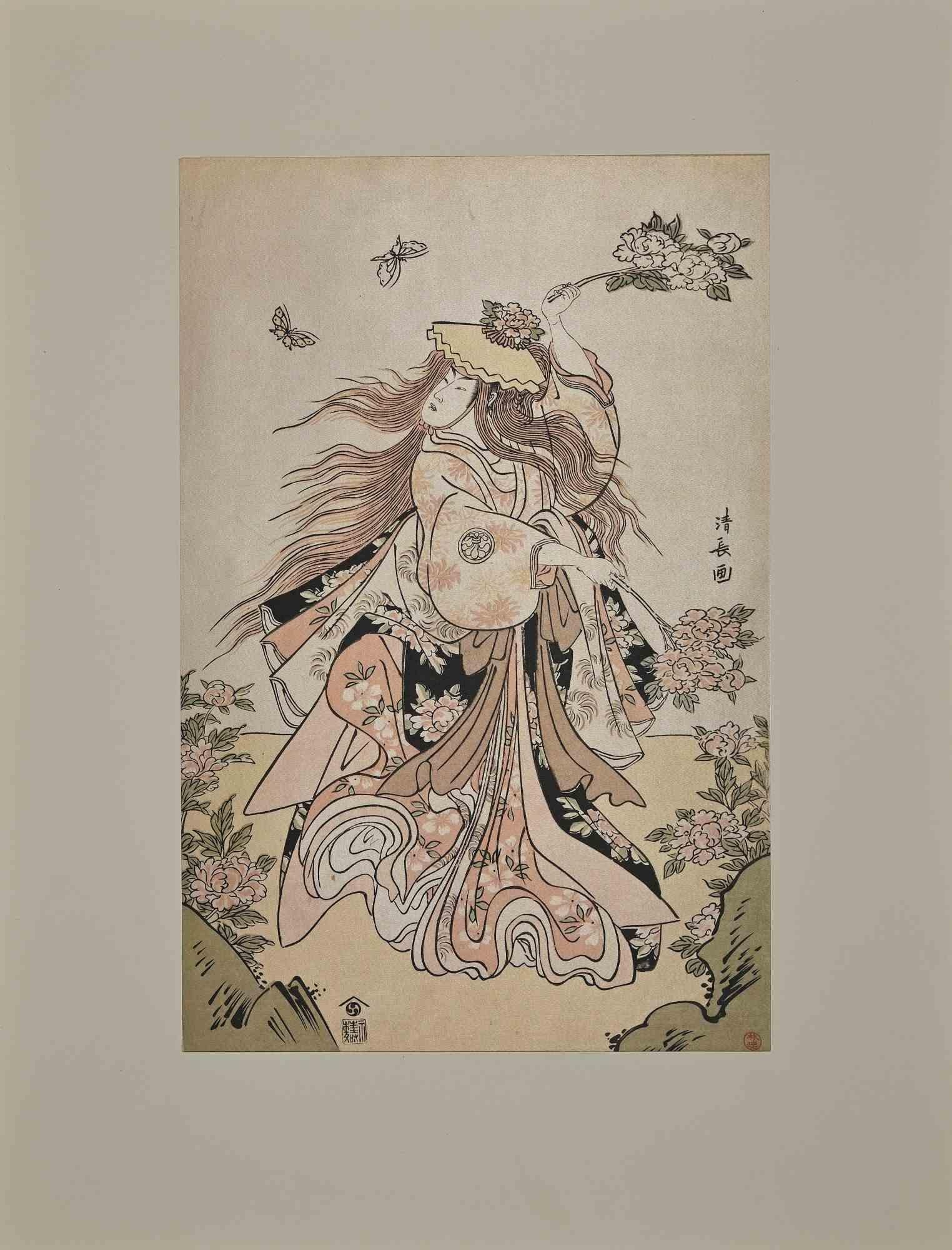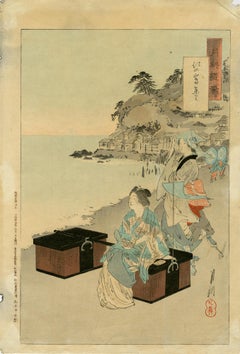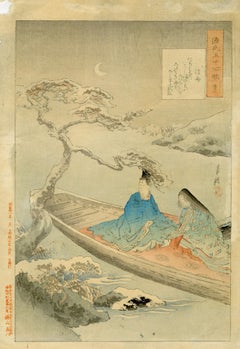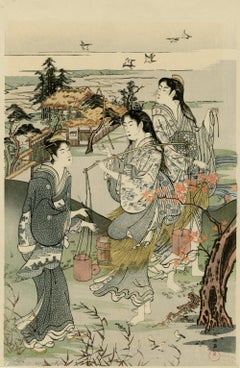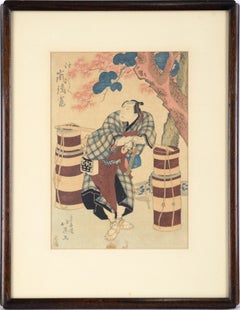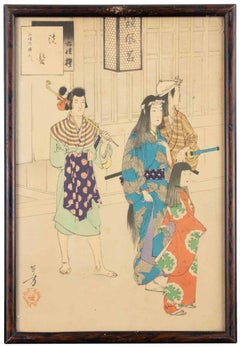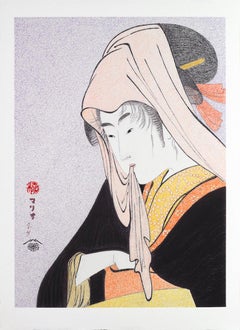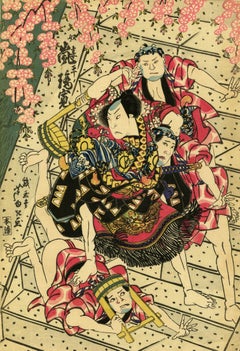Items Similar to Street Singers (Ukiyobushi), Shamisen Player and Singer
Want more images or videos?
Request additional images or videos from the seller
1 of 2
Takahashi Hiroaki (Shotei)Street Singers (Ukiyobushi), Shamisen Player and Singer1936
1936
$350
£265.39
€306.52
CA$491.07
A$547.04
CHF 288.56
MX$6,633.06
NOK 3,670.85
SEK 3,419.63
DKK 2,288.91
About the Item
Watanabe Shozaburo, 1936. Woodblock in colors on handmade mulberry paper, Koban 182 x 120 mm, full margins. With the Shôtei artist seal in red ink, upper right. Signed "Shotei" and titled in English on the matrix in graphite. With the "Made in Japan" export stamp and the Watanabe catalog number stamp 179, both in blue ink, on the bottom sheet edge, verso, as issued. Adhered to a card stock matrix with deckle edges, as issued. A beautiful pre-war impression of this serene and peaceful scene, good gradient inking and luminosity in the lantern. Printed by hand with cherrywood blocks.
*Marc Kahn, Shotei catalog S10; Watanabe 179
Born in Tokyo in 1871, Hiroaki Takahashi was working as an artist in an official capacity at an incredibly young age. After an early apprenticeship with his uncle, Matsumoto Fuko (who awarded the young boy the name Shôtei), Takahashi was hired by the Imperial Household Department of Foreign Affairs to copy designs for ceremonial objects.
By the age of 18, Shôtei was a co-founder of the Japan Youth Painting Society, and by 1907 he had been recruited by Shōzoburō Watanabe to produce prints for his Shin Hanga movement. The Shin Hanga or "New Print" movement served to satisfy the widespread demand in the Western world for the export of traditional Ukiyo-e prints in the style of masters like Hiroshige. Shôtei enjoyed tremendous success in this endeavor, however, it was cut devastatingly short in 1923.
On September 1st of 1923, the Great Kanto Earthquake, also known as the Tokyo-Yokohama earthquake of 1923, struck the Tokyo metropolitan area without warning with a magnitude of 7.9. Up until that point in time it was the worst natural disaster recorded in the history of earthquake-prone Japan. The earthquake, which is said to have lasted up to ten mintues, caused a tsunami, a rotational wind burst with a burning core called a "fire whirl," and extensive firestorms, which quickly spread across the main island of Honshū. Watanabe's facility was reduced to ashes, and the inferno took every single woodblock with it. Lucky to have survived the devastation, Shôtei, now having added the name Hiroaki, spent the rest of his life recreating his lost woodblocks, as well as creating a handful of new designs.
There is some speculation that impressions of woodblocks with the kanja characters reading Shôtei, versus Rakutei, may indicate pre-earthquake impressions versus post-earthquake impressions, printed from a block recreated by the artist after his own design. The signature and title on this work would have been added in English by an assistant in preparation for its export to the West. Despite a persistent bit of misinformation that Shôtei died in the atomic bombing of Hiroshima, he actually died of pneumonia in February of 1945, at the age of 74.
- Creator:Takahashi Hiroaki (Shotei) (1871 - 1945, Japanese)
- Creation Year:1936
- Dimensions:Height: 7.19 in (18.27 cm)Width: 4.75 in (12.07 cm)
- Medium:
- Period:
- Condition:
- Gallery Location:Middletown, NY
- Reference Number:Seller: BH5251stDibs: LU1979212853472
About the Seller
5.0
Gold Seller
Premium sellers maintaining a 4.3+ rating and 24-hour response times
Established in 2004
1stDibs seller since 2022
70 sales on 1stDibs
Typical response time: 3 hours
- ShippingRetrieving quote...Shipping from: Middletown, NY
- Return Policy
Authenticity Guarantee
In the unlikely event there’s an issue with an item’s authenticity, contact us within 1 year for a full refund. DetailsMoney-Back Guarantee
If your item is not as described, is damaged in transit, or does not arrive, contact us within 7 days for a full refund. Details24-Hour Cancellation
You have a 24-hour grace period in which to reconsider your purchase, with no questions asked.Vetted Professional Sellers
Our world-class sellers must adhere to strict standards for service and quality, maintaining the integrity of our listings.Price-Match Guarantee
If you find that a seller listed the same item for a lower price elsewhere, we’ll match it.Trusted Global Delivery
Our best-in-class carrier network provides specialized shipping options worldwide, including custom delivery.More From This Seller
View AllThe Lonely House at Asajigahara.
Located in Middletown, NY
A scene from a series of ghost stories and spooky rural legends.
Tokyo: Matsuki Heikichi, 1896.
Woodcut in ink with embossing and hand-coloring in watercolor on handmade mulberry pa...
Category
Late 19th Century Edo Figurative Prints
Materials
Watercolor, Handmade Paper, Woodcut
Pilgrimage to Enoshima
Located in Middletown, NY
Tokyo: Matsuki Heikichi, 1893
Woodcut in ink with embossing and hand-coloring in watercolor on handmade mulberry paper, 14 1/2 x 9 7/8 inches (368 x 251 mm), ōban tate-e, full margi...
Category
Late 19th Century Edo Portrait Prints
Materials
Handmade Paper, Watercolor, Woodcut
Courtiers under a wisteria draped pine tree
Located in Middletown, NY
Tokyo: Yokoyama Ryohachi, 1892
Woodcut in ink with embossing and hand-coloring in watercolor on handmade mulberry paper, 14 1/2 x 9 7/8 inches (368 x 251 mm), ōban tate-e, the full ...
Category
Late 19th Century Edo Portrait Prints
Materials
Watercolor, Handmade Paper, Woodcut
Mu-Tamagawa
Located in Middletown, NY
Woodcut in ink with embossing and hand-coloring in watercolor on laid Japon paper, 16 x 10 inches (406 x 253 mm), ōban tate-e, full margins. Scattered handling wear and toning, other...
Category
Late 19th Century Edo Portrait Prints
Materials
Watercolor, Handmade Paper, Woodcut
The Actors Nakajima Wadaemon as Bōdara Chōzaemon and Nakamura Konozō as Gon of t
Located in Middletown, NY
Two minor villains from "Medley of Tales of Revenge" square off, as performed at the Kiri theatre, Tokyo, in May of 1794.
Toyko: Tsutaya Juzaburo, 1794.
Woodblock (nishiki-e) with ...
Category
Late 18th Century Edo Portrait Prints
Materials
Watercolor, Handmade Paper, Woodcut
Toshogu Shrine
Located in Middletown, NY
In image of the Tokugawa family paying homage to Tosho-gu Shrine in Nikko.
Tokyo: Matsuki Heikichi, 1896
Woodcut in ink with embossing and hand-coloring in watercolor on handmade m...
Category
Late 19th Century Edo Figurative Prints
Materials
Watercolor, Handmade Paper, Woodcut
You May Also Like
Actor Arashi Rikan II as Aburaya Yohei - Figurative Woodblock Print on Paper
Located in Soquel, CA
Actor Arashi Rikan II as Aburaya Yohei - Figurative Woodblock Print on Paper
Woodblock print of kabuki actor by Shunbaisai Hokuei (Japanes...
Category
1830s Edo Figurative Prints
Materials
Paper, Ink, Woodcut
Sanjûroku Kasen... - Woodcut by Mizuno Toshikata - 1893
By Mizuno Toshikata
Located in Roma, IT
Nishiki-e (woodcut print), in vertical oban format (31x20.5) realized by Mizuno Toshikata in 1893 (Meiji 26).
Belongs to the Series "Sanjûroku Kasen" (Thirty-Six Beauties in Compari...
Category
1890s Modern Figurative Prints
Materials
Woodcut
Japanese Art Figurative Painting, Love for a street-walker, Edo period
Located in Segovia, ES
LOVE FOR A STREET-WALKER
Crayon, graphite, pencil on paper.
Measurements: (H) 76 x (W) 56 cm.
Attractive portrait of an Edo prostitute hurrying through the streets. She wears a black kimono over layers of colored kimono, tucking her hand into the "obi" at her waist. A white scarf is draped over her head, the edge caught between her teeth, and loose wisps of hair framed her face. There is an impressive contrast between the black kimono and the yellow-orange of collars, sleeves and "obi", balancing the composition the pastel pink of the scarf that covers her head.
This image is part of the "bijin-ga" series, Pretty Women, drawn by Mario BGil, based in the Kitigawa Utamaro woodblock print "Love for a street-walker" (1795), 37,2 x 24,6 cm. The British Musem. London, UK.
The artist reproduces the seal of the censor (Kiwame) and from the original publisher ("Tsutaya", climbing leaf)), between the two, the signature of Mario BGil written in Japanese, with the date 14 (2014).
The mesaurements of the drawing are 76 x 56 cm. (29,92 x 22,05 in.), with a painted surface of 67 x 49,5 cm.
With his work on the "bijing-ga" series, Mario BGil wanted to embellish, give brilliance and volume to the images presented by japanese artist Kitigawa Utamaro in those beautiful engravings, ennobled with the patina of time, which have served as inspiration. The result obtained is almost life-size portraits, endowed with strong chromaticism and valuable contrasts, all enhanced, in turn, with the volume provided by the weight and rigidity of the paper, and its thick texture (Fabriano Artistico “grana grosso”, 640g/m2; the thickness and hardness of the paper makes it necessary to transport it without rolling).
In this way, Mario BGil pays tribute to his admired artist and offers us a new and enriched vision of this popular facet of oriental art from the 18th and 19th centuries.
ABOUT THE ARTIST
Mario BGil is a self-taught artist who for years has combined his creative activity with his work in the family business, away from commercial art galleries. In 2012, a deep interest in oriental art was awakened in him and he began to study the great masters of Japanese Ukiyo-e prints, who had such an influence on the European avant-garde of the late 19th century.
The discovery of Kitagawa Utamaro (1753-1806), a key figure in the metropolitan culture of Edo (now Tokyo), and a point of reference in the history of Japanese engraving...
Category
2010s Edo Figurative Drawings and Watercolors
Materials
Crayon, Paper, Pencil, Graphite
Arashi Rikan II in an Osaka Kabuki Scene
Located in Fairlawn, OH
Arashi Rikan II in an Osaka Kabuki Scene
Color woodcut, c. 1827
Signed middle left (see photo)
Titled upper left (see photo)
Format: oban
Publisher: Honsei
The actor, in character, d...
Category
1820s Other Art Style Figurative Prints
Materials
Woodcut
Sanjûroku Kasen ... - Woodcut by Mizuno Toshikata - 1893
By Mizuno Toshikata
Located in Roma, IT
Nishiki-e (woodcut print), in vertical oban format (31x20.5) realized by Mizuno Toshikata in 1893 (Meiji 26).
Belongs to the Series "Sanjûroku Kasen" (Thirty-Six Beauties in Compari...
Category
1890s Modern Figurative Prints
Materials
Woodcut
Actor Segawa Kikunojô III - Woodcut after Torii Kiyonaga - Mid-20th Century
By Torii Kiyonaga
Located in Roma, IT
Actor Segawa Kikunojô III Performing the Lion Dance is a woodcut print realized in the early 20th Century after Torii Kiyonaga's Woodcut.
Good conditions....
Category
Early 20th Century Modern Figurative Prints
Materials
Woodcut
More Ways To Browse
Antique Street Signs
Antique Singer
Record Player Record Player
Used Card Catalogs
Antique Bombs
Japanese Paper Lantern
Card Players
Antique Street Lantern
Antique Street Lanterns
Antique Paper Lantern
Antique Earthquake
Atomic Bomb
Atomic Bombs Used
Antique Post Lanterns
Watanabe Woodcut
Seal Matrix
Used Shamisen
Hiroaki Takahashi

